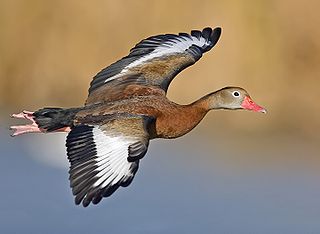
The International Union for Conservation of Nature (IUCN) Red List of Threatened Species, founded in 1964, is the world's most comprehensive inventory of the global conservation status of biological species. It uses a set of criteria to evaluate the extinction risk of thousands of species and subspecies. These criteria are relevant to all species and all regions of the world. With its strong scientific base, the IUCN Red List is recognized as the most authoritative guide to the status of biological diversity. A series of Regional Red Lists are produced by countries or organizations, which assess the risk of extinction to species within a political management unit.

The whistling ducks or tree ducks are a subfamily, Dendrocygninae, of the duck, goose and swan family of birds, Anatidae. In other taxonomic schemes, they are considered a separate family, Dendrocygnidae. Some taxonomists list only one genus, Dendrocygna, which contains eight living species, and one undescribed extinct species from Aitutaki of the Cook Islands, but other taxonomists also list the white-backed duck under the subfamily.

Red-cheeked squirrels form a taxon under the subfamily Callosciurinae. The six species which are all found only in Asia are listed as "Least Concern" by the IUCN.

Callosciurus is a genus of squirrels collectively referred to as the "beautiful squirrels". They are found mainly in Southeast Asia, though a few species also occur in Nepal, northeastern India, Bangladesh and southern China. Several of the species have settled on islands. In total, the genus contains 15 species and numerous varieties and subspecies. The genera Glyphotes, Rubrisciurus, and Tamiops have sometimes been included in Callosciurus.

Orthetrum is a large genus of dragonflies in the Libellulidae family. They are commonly referred to as skimmers.
This article is a list of biological species, subspecies, and evolutionary significant units that are known to have become extinct during the Holocene, the current geologic epoch, ordered by their known or approximate date of disappearance from oldest to most recent.
The Biak monarch, or Biak monarch flycatcher, is a species of bird in the family Monarchidae. It is endemic to Biak Island, Indonesia.

Anderson's shrew is a medium-sized species of shrew. It is light gray in color with yellow fur around the throat and pectoral region, comparatively large ears and a tail that measures about 50 – 70% of body length. This shrew species is widespread, found in India, Nepal, Pakistan and possibly Bangladesh, in gardens and grassy embankments near watercourses, under piles of brushwood in forest plantations (Punjab) as well as the bases of stone walls in Kathiawar, and also in desert and arid country. As far as is known, the habits of the Anderson's shrew are largely nocturnal and solitary. Breeding may extend throughout the year.
Amphidromus cognatus is a large camaenid land snail endemic to Australia.
Bat Conservation International (BCI) is an international nongovernmental organization working to conserve bats and their habitats through conservation, education, and research efforts.

The World's 25 Most Endangered Primates is a list of highly endangered primate species selected and published by the International Union for Conservation of Nature Species Survival Commission Primate Specialist Group, the International Primatological Society (IPS), and Conservation International (CI). The 2012–2014 list added the Bristol Conservation and Science Foundation (BCSF) to the list of publishers. The IUCN/SSC PSG worked with CI to start the list in 2000, but in 2002, during the 19th Congress of the International Primatological Society, primatologists reviewed and debated the list, resulting in the 2002–2004 revision and the endorsement of the IPS. The publication has since been a joint project between the three conservation organizations and has been revised every two years following the biannual Congress of the IPS. Starting with the 2004–2006 report, the title changed to "Primates in Peril: The World's 25 Most Endangered Primates". That same year, the list began to provide information about each species, including their conservation status and the threats they face in the wild. The species text is written in collaboration with experts from the field, with 60 people contributing to the 2006–2008 report and 85 people contributing to the 2008–2010 report. The 2004–2006 and 2006–2008 reports were published in the IUCN/SSC PSG journal Primate Conservation, while the 2008–2010 and 2010-2012 report were published as independent publications by all three contributing organizations.

Alycaeus is a genus of small land snails with a gill and an operculum, terrestrial gastropod mollusks in the family Cyclophoridae. It is the type genus of the subfamily Alycaeinae.









